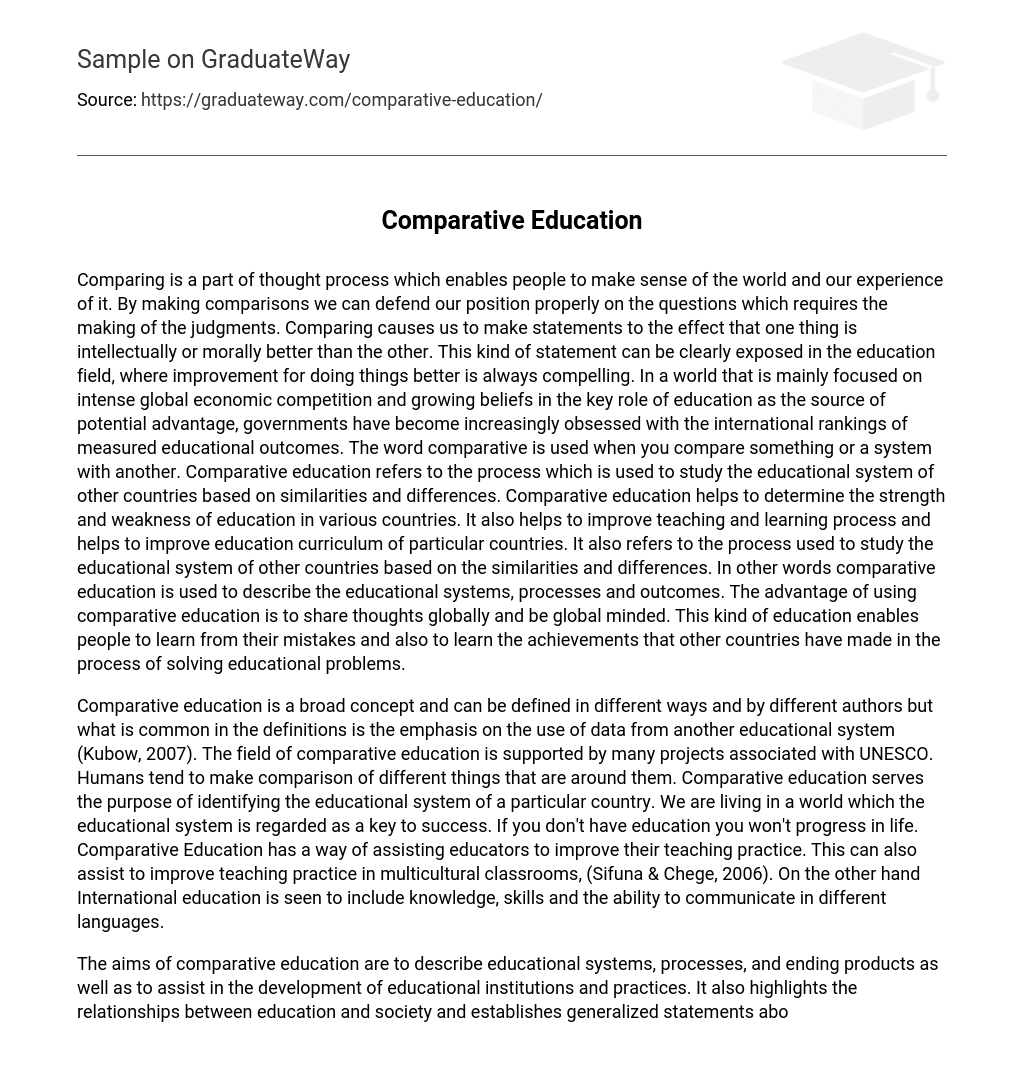Comparing is a part of thought process which enables people to make sense of the world and our experience of it. By making comparisons we can defend our position properly on the questions which requires the making of the judgments. Comparing causes us to make statements to the effect that one thing is intellectually or morally better than the other. This kind of statement can be clearly exposed in the education field, where improvement for doing things better is always compelling. In a world that is mainly focused on intense global economic competition and growing beliefs in the key role of education as the source of potential advantage, governments have become increasingly obsessed with the international rankings of measured educational outcomes. The word comparative is used when you compare something or a system with another. Comparative education refers to the process which is used to study the educational system of other countries based on similarities and differences. Comparative education helps to determine the strength and weakness of education in various countries. It also helps to improve teaching and learning process and helps to improve education curriculum of particular countries. It also refers to the process used to study the educational system of other countries based on the similarities and differences. In other words comparative education is used to describe the educational systems, processes and outcomes. The advantage of using comparative education is to share thoughts globally and be global minded. This kind of education enables people to learn from their mistakes and also to learn the achievements that other countries have made in the process of solving educational problems.
Comparative education is a broad concept and can be defined in different ways and by different authors but what is common in the definitions is the emphasis on the use of data from another educational system (Kubow, 2007). The field of comparative education is supported by many projects associated with UNESCO. Humans tend to make comparison of different things that are around them. Comparative education serves the purpose of identifying the educational system of a particular country. We are living in a world which the educational system is regarded as a key to success. If you don’t have education you won’t progress in life. Comparative Education has a way of assisting educators to improve their teaching practice. This can also assist to improve teaching practice in multicultural classrooms, (Sifuna & Chege, 2006). On the other hand International education is seen to include knowledge, skills and the ability to communicate in different languages.
The aims of comparative education are to describe educational systems, processes, and ending products as well as to assist in the development of educational institutions and practices. It also highlights the relationships between education and society and establishes generalized statements about education that is valid in more than one country. Comparative education also deepens our understanding of our education and society it can be of great aid to policy makers and administrators and can be of great asset in the education of teachers (Bray 2007, p.15). Comparative research also helps us understand better our own past locate ourselves more exactly in the present and see more clearly what our educational future may be. Comparative education gives the researcher the ability to describe what might be the consequence of certain courses of political and economic action, by looking at experience in a range of countries. From the theories mentioned above extracted from different scholars, we can see that comparative education facilitates the researchers to learn from the accomplishment and faults that other countries have made in the process of solving similar educational problems. The focal point of comparative study in education is the collection and categorization of information, both descriptive and quantitative. While less developed countries have a tendency to look at more developed countries to learn from them, more developed countries tent to look at countries that are on the same economic and educational level to make cross-national comparisons across time provide information about improvement or decline over the years like comparing the different periods in the history of education. The ways in which educators in different countries view these issues and the strategies employed to address them must be understood in the light of different cultural, social and political context in each country. By viewing the educational issue from the perspective of two diverse countries the researcher can identify factor that might be missed when viewing the issue within the context of own country alone.
REFERENCES
- Kobow, P.K & Fossum P.R. (2007). Comparative Education: Exploring issues in international context. Upper Saddle River, New Jersey: Pearson Education.
- Sifuna D.N., Chege & Oanda I. (2006).Theme in the Study of The Foundations of Education of Education, Jomo Kenyatta Foundation, Nairobi.





